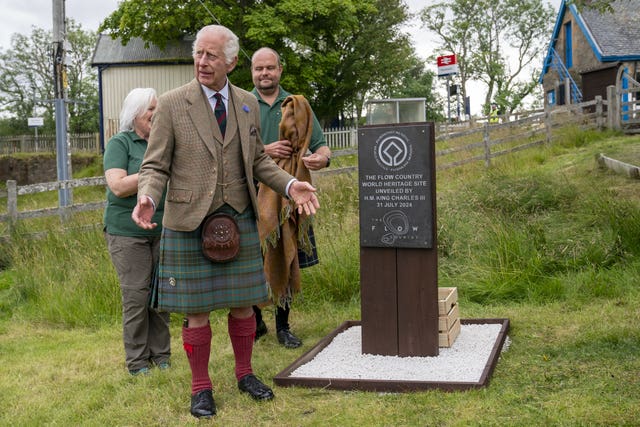The King is visiting a giant bog which was recently given world heritage site status.
Charles arrived at the vast expanse of peatland at Forsinard Flows, Forsinard, Sutherland, on Wednesday.
The area is estimated to store about 400 million tonnes of carbon dioxide, more than is stored by all UK woodlands combined.
The Flow Country is widely considered to be the largest area of blanket bog in the world and covers about 1,500 square miles in the Highlands.

Heritage chiefs at Unesco (the United Nations Educational, Scientific and Cultural Organisation) recognised the importance of the area on July 26 – making it the UK’s 35th world heritage site, and the seventh in Scotland.
Charles, a renowned nature lover who is patron of the Royal Society for the Protection of Birds (RSPB), will meet representatives of the charity, as well as from NatureScot – which led the bid for Unesco recognition – and Highland Council.
He will be shown how the peatlands function as a “centre of excellence” for research, and are home to a vast range of plants and wildlife.
The King will be given a tour of the Forsinard Flows visitor centre and meet staff from the Flow Country Partnership, which was formed in 2006 to restore the peatland of the Flow Country after damage from forestry and drainage.

He will also meet neighbours of the “national treasure” at a community event, attended by families and local businesses.
The peatlands is a habitat for some of the world’s most diverse bog ecosystems, and acts as a crucial defence against climate change, locking away carbon so it is not released as carbon dioxide.
Charles will be told about how the area provides economic opportunities and a space for young people to experience nature.
He took on the patronage of the RSPB following the death of his mother, Queen Elizabeth II.
The area was hailed for its “international importance as a habitat and for the diverse range of rare and unusual breeding birds it supports” by Scottish Secretary Ian Murray when the Unesco status was granted.





Comments: Our rules
We want our comments to be a lively and valuable part of our community - a place where readers can debate and engage with the most important local issues. The ability to comment on our stories is a privilege, not a right, however, and that privilege may be withdrawn if it is abused or misused.
Please report any comments that break our rules.
Read the rules here